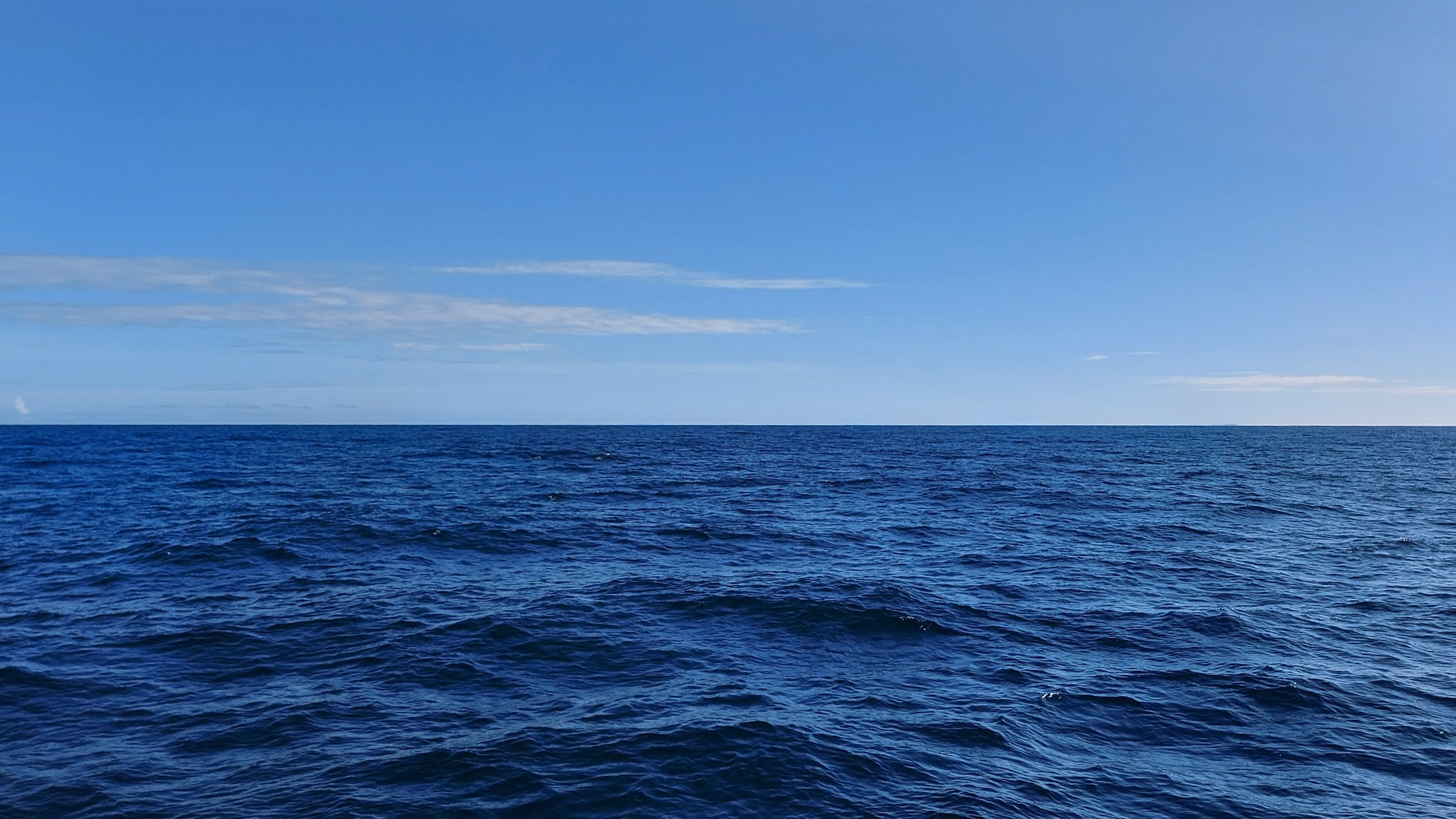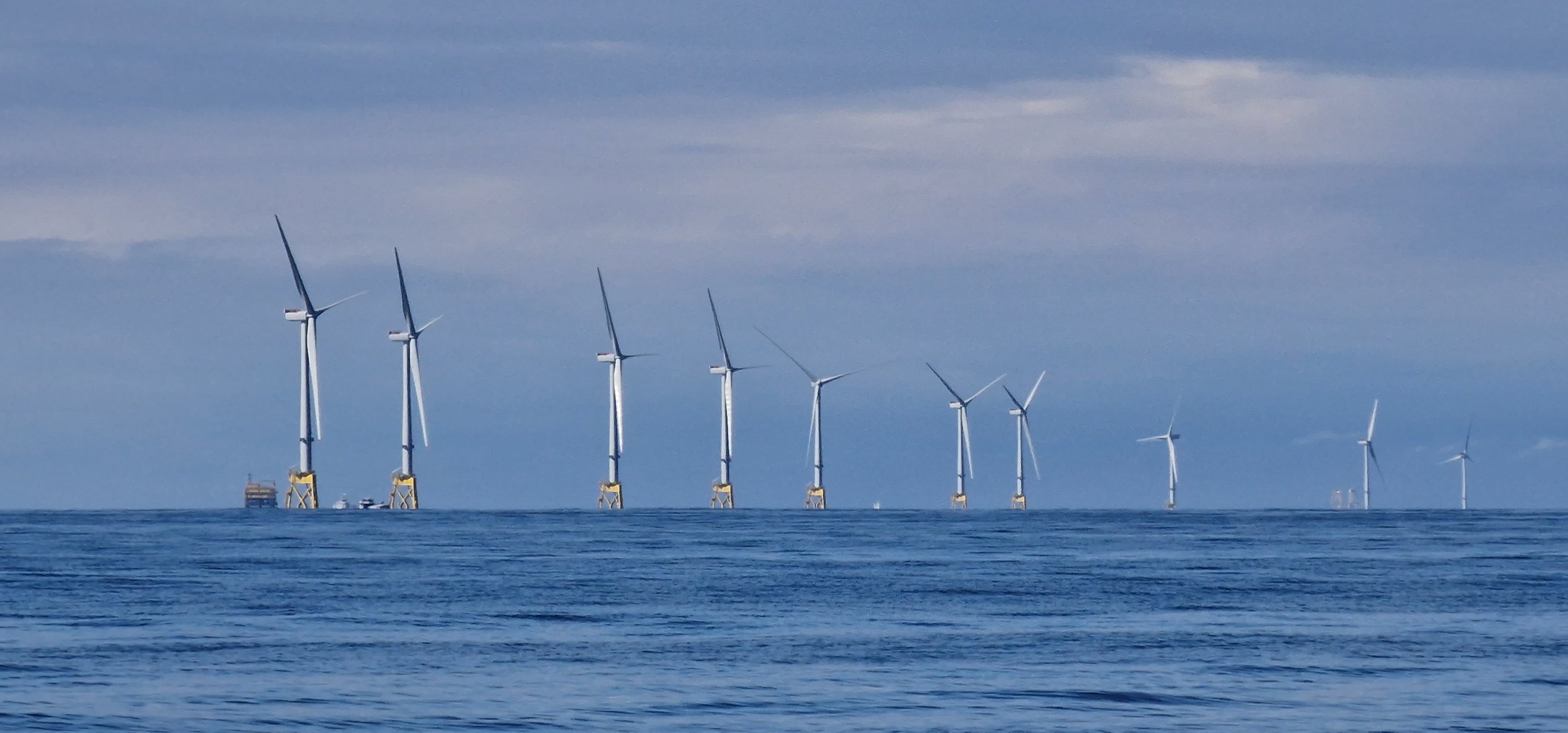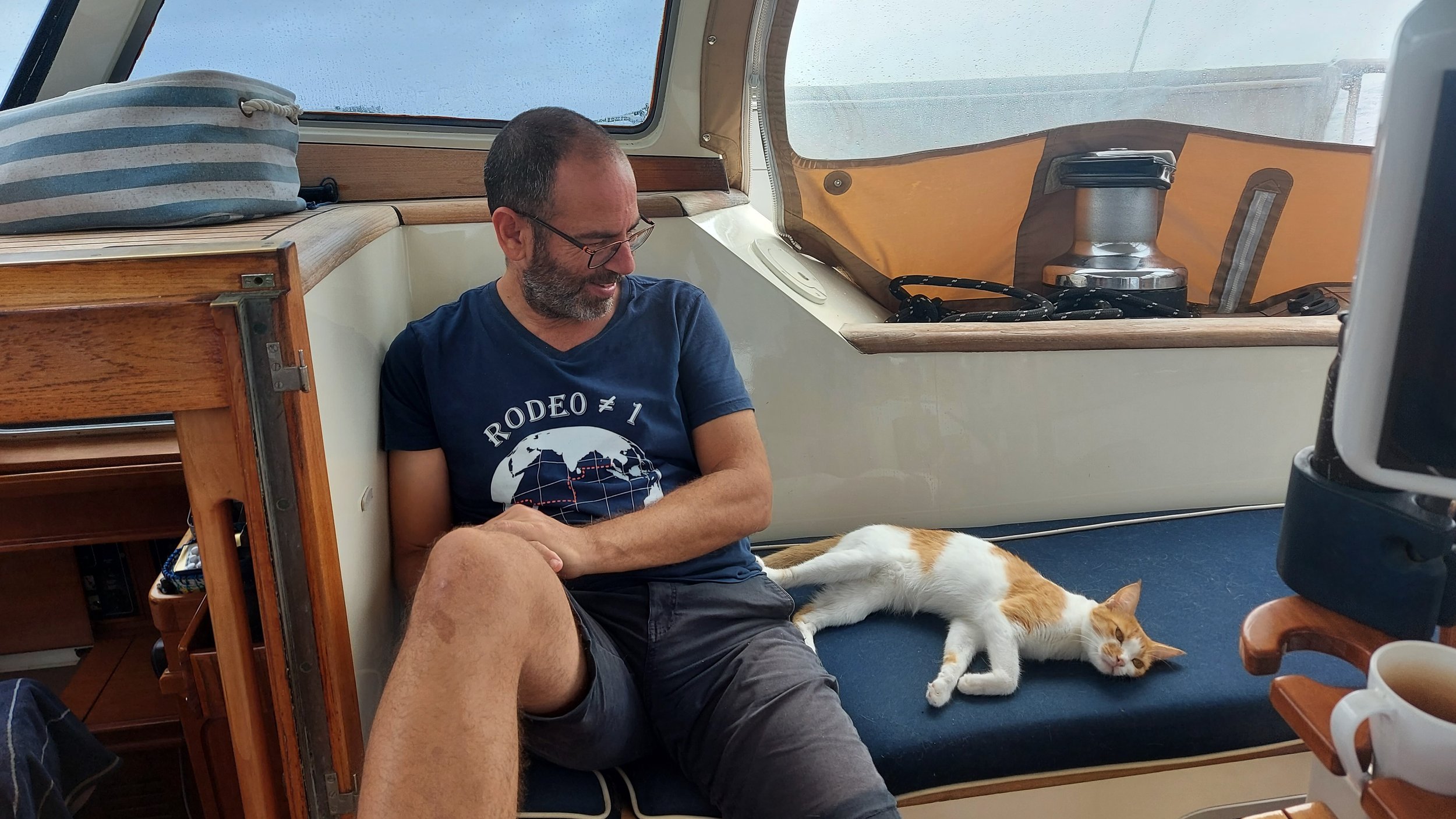Turning the weather off

Day 12 : Ascension Island to Azores
Tuesday, March 29th 2022
It’s 5.45am, and I’m sitting in my “on watch” position, tucked into the corner of the cockpit on the low side, allowing gravity to hold me in place.
First light is just breaking, and I get up to scan the horizon. Even just standing is an effort – the wind is gusting around 19 knots, which means it’s 23 knots apparent wind due to our own forward speed, so the boat is heeled over well past my 15 degree “comfort” target.
The waves have built a little in the last 20 minutes too, so the bow is now being lifted up and falling off the back of each wave. Steely doesn’t slam some like modern hull designs do, thankfully, but she still displaces a huge amount of water with a soft, but impressive “whumpf” as she lands off the back of each wave.
There’s nothing to see, apart from a lot of white caps, and streaks of foam forming our wake as we push forward at close to 7 knots. I sit back down and continue planning what I’m going to write in my Day 11 blog.
At 6am, as always, I go to down to the galley and put the kettle on. Time to make the first coffee of the day, and then back to the cockpit where I’ll write the blog and upload it at the same time as downloading the latest weather forecast.
As I put the kettle on the stove, I catch a glint of a reflection of my head torch where there shouldn’t be one - on the window sill of the galley portlight.
My subconscious processes this data quickly - that sill is matt varnish and ought not to be reflective. What’s going on there? I lean over the various jars in front of the window to have a closer look.
Hmmm, there’s half a cup of water sloshing around on the window sill. Since this is on the low side of the boat, the water is being held in place by gravity, otherwise it would have drained away and I might never have seen it. But it’s quite clear – our window is leaking.
As I’m watching, we fall off another wave, and with a mighty gurgle, the window disappears underwater and tons of ocean get pressed against it and rush past.
I flinch reflexively, but as it re-emerges, and streams of water run down it, I see that it held just fine. That’s hardly surprising – this high pressure dunking of the window is happening every 10 seconds, and has been for over 24 hours now since it’s on the low side of the boat.
There’s no reason why it would suddenly collapse as I’m watching that particular wave, but the pool of water sloshing around on the inside is still somewhat unsettling.
I’m not entirely surprised by the leak though. Steely is generally a very dry boat – it’s one of the advantages of steel versus fibreglass – but the only other major leak we’ve had before was the equivalent window on the starboard side of the boat.
Both these two portlights were originally permanently closed, but when we refit the boat in Sydney in 2017, we specified for them to be replaced with opening portlights to allow for cross ventilation and also the disposal of organic scraps overboard when we’re cooking at anchor.
The change achieved it’s objective, but to this day we feel the shipwright who was managing the refit chose the wrong portlights. These ones have small levers that you twist through 90 degrees to lock them closed. Elsewhere on the boat, we have another pair of opening portlights by the same manufacturers, but these have screw-in knobs, which allows you to “dog them down” more tightly against the rubber seal – this seems like an eminently more sensible solution for windows that are being submerged, and we pointed this out to the shipwright at the time.
She assured us that our “dog-down” type were simply the older models, and the new ones she’d ordered were the latest and greatest. In my naiveté I accepted her explanation, but it seems more likely to me with hindsight and a few more miles under our belt that she’d simply ordered the wrong ones and didn’t want to pay for her mistake. This is just one of many examples from our refit where we now think “If we only knew then, what we know now…”
On our very first passage on setting off on our circumnavigation, predictably enough one of them started leaking (the one opposite the galley window). When we pulled into the Gold Coast, we worked out how to tighten the handles to form a better seal – it’s not as effective as the other style of portlight, but it’s better than nothing.
Since then neither has leaked, but there are probably two contributing factors to that: we have a pre passage routine of checking to ensure they’re as tight as we can make them; and we haven’t really been doing much upwind sailing, which is when these windows are immersed.
I mop up the water, and watch for 5 minutes to assess the level of ingress. It’s very slow – less than half a teaspoon in that time, despite being violently dunked underwater at least 20 times while I’m watching.
So the good news is that it’s not likely to sink the boat any time soon. But we still need to try and address it if we can.
The first step is to see if I can tighten the lever further while the window is still closed.
I go to our tool shed and dig out the special socket we had modified to fit the nuts on the window lever. The nuts are deep set inside the lever in such a way that a normal socket won’t fit – we needed to grind the outer wall of a size 10 socket to make it’s diameter substantially thinner, to fit inside the aperture.
One of the nuts is pretty tight, but the other is loose. Unfortunately, I can’t tighten it without holding the bolt on the outside of the window with a hex wrench.
I briefly consider trying to open the window, tighten the nut and close it again, in the 10 seconds between waves. Another violent dunking disabuses me of that notion. The consequences of getting it wrong are not hard to imagine - vast quantities of water being violently projected into the boat through a half metre square sized hole, immersed one metre under water, as the water rushes by at speed.
Also not hard to imagine would be the explaining I’d have to do to Jen, who is currently asleep in the aft cabin, mercifully oblivious to the stupid ideas swirling around in my head.
Given the slow rate of ingress, I decide to wait until Jen is awake a little later, and we can tackle it together.
After breakfast, we talk through our plan. We clearly can’t open the window while sailing along like this. One option is to simply tack, putting the window on the high side. The downside of this is that the high side of the boat is actually where the waves strike, so although the window wouldn’t be immersed under water, we could still have plenty of water dousing us as we’re trying to work.
A better plan is to Heave To – the process of setting two sails against each other to counteract one another – which has the effect of stopping the boat in the water.
This is a very effective tactic in storm conditions, or really any time you just need to temporarily “turn the weather” off – maybe to do some urgent maintenance, or even to get a good night’s sleep if you’re exhausted.
By heaving to, the boat essentially comes upright in the water, and then drifts very slowly down wind. Set up correctly, the boat can be left to it’s own devices for days on end, so long as you have the sea-room and are not going to drift into anything.
Out here, with over a thousand miles to the nearest bit of land, that’s not going to be a problem.
What is a small problem, though is that we’ve never put Steely into a heave to position before. I’ve hove to many times, but always on other boats.
On most boats, It’s generally a straightforward process. Since you want the mainsail on one side of the boat, and the headsail on the other, and they’re generally both on the same side when you’re sailing, all you need to do is tack the boat, but not touch of the lines.
The main will fall into place as it should on the new tack, but the headsail, since you have not released the lines, stays on the “wrong side” of the boat, backwinding itself, and voila – you’ve hove to.
All that remains is some adjustment to the helm to find the optimum rudder position to hold the boat without turning, and you can lock it off and get on with whatever you want to do.
The problem on Steely is that we have 4 sails, not two. And depending on what combination we have up, creating those balanced, but opposing forces, may not be quite so simple.
We’ve often talked about having a session practicing heaving to, so we would know what would work best if we ever needed to do it “in anger”, but in truth we never have. Partially because we always had better things to do when we’re sailing along, and partially because it’s not that hard really, and we figured we’d work it out the first time we needed to.
The time had arrived.
We essentially have 4 combinations that could theoretically work:
• Mainsail and genoa
• Mainsail and Staysail
• Mizzen and Genoa
• Mizzen and Staysail
Mainsail and Genoa is the most obvious option, as it’s what almost all “normal” boats have. However, we almost never fly just that combination of sails.
Currently we have up our most common combination – Genoa and Mizzen, but there are two theoretical downsides to that combo for heaving to. The first is that the sails are a long way apart – the genoa at the very front of the boat, the mizzen at the very back, and I guess that since the interplay between the two sails is part of what’s required to create the balance, having them closer to one another might help.
The other is that our genoa is huge, even in its currently reefed position. So the force from it is likely to overwhelm the mizzen, making balance harder to achieve.
I’ve also always felt that using the staysail would be better on Steely for heaving to because of it’s sheeting arrangement – with just one sheet which comes to a central position and then back to the cockpit, it means that we would not have to deal with one of the downsides of heaving to on most boats - which is the potential chafe you have on the genoa sheet, as backwinding it usually means the active sheet is lying against the shrouds with a LOT of pressure in it.
With all of the above I mind, we decide to put the genoa away, pull out the staysail, and then tack the boat, and see what happens.
5 minutes later, we’ve swapped the two sails and we tack the boat.
Somebody switched the weather off!
Although I’ve hove to many times before, the immediacy and extent of the impact still always comes as a surprise. From being heeled over at close to 20 degrees, waves crashing against the boat, and the aforementioned violent dunking of the window, in an instant we’re now totally level, the waves gently rolling Steely from side to side, but all wind noise and rushing water gone. It’s like we’re in a weird oasis of calm, in the middle of a boiling and heaving ocean.
We spend a few minutes finding the optimum helm angle to hold Steely at 60 degrees to the wind, and set to work on the window.
10 minutes later, I’ve tightened the loose lever bolt, and we’ve checked the window on the other side, just for good measure.
We take the opportunity of a flat boat to do a few other jobs – address an issue with our furling line on the genoa, check the anchor is still tied down securely, bleed the fridge and get the generator running.
During this time, Steely just bobs away, quite content, drifting slowly and calmly at 1 knot downwind.
When we’re ready to resume, we simply return to the other tack, put away the staysail and pull out the genoa. 3 minutes later, we’re hammering along with the waves rushing by, back to top speed and it’s like the whole oasis of calm was just a dream.
The window is still leaking – but at a much slower rate – probably one tablespoon of water in the 24 hours since we tightened the lever. I just don’t think this type of sealing mechanism is designed to withstand the forces of such violent and repeated dunking below the waterline.
So it’s something to keep an eye on in the meantime, and to add to the long list of items we want to address when we’re in the UK and undertaking a mid-circumnavigation refit.
And best of all, almost half-way round the world, we’ve finally learned how to turn the weather off with Steely whenever we like.
Day 12 Statistics:
Time on passage so far: 11 days, 21 hours
Distance covered in last 24 hours: 121 nm
Average Speed in last 24 hours: 5.0 knots
Official Length of intended Route when we set out: 3,480 nm
Current Projected Distance to Go according to chart plotter: 1,971 (2,088) nm
Distance Sailed so Far: 1,423 nm
Total Projected Distance of Route: (1,971 + 1,423) 3,394 nm
Change in total projected distance in last 24 hours: +5 miles.
Number of items on the mid-circumnavigation refit list so far: 41





